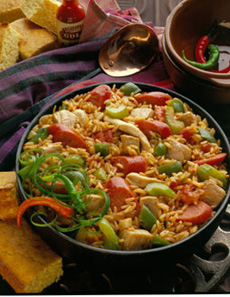
 Jambalaya, a Cajun dish adapted from Spanish paella, uses long-grain white rice as a base for a topping of highly-seasoned seafood and meats. Photo courtesy National Pork Board. Jambalaya, a Cajun dish adapted from Spanish paella, uses long-grain white rice as a base for a topping of highly-seasoned seafood and meats. Photo courtesy National Pork Board.
February 2010 |
 |
Cajun Jambalaya Recipe With Grilled Chicken & Smoked Sausage
An Easy, Hearty Food, Perfect For Crowds
CAPSULE REPORT: Jambalaya is a delicious, spicy, main course consisting of rice and practically everything else in the refrigerator! It’s a great way to use favorite meats and veggies (shrimp, peas, carrots, bell peppers), including leftovers! It’s also an economical and easy way to feed a large group—Super Bowl Sunday, Oscar parties, even outdoor fêtes. This jambalaya recipe is courtesy of grilling bloggers (and sisters) Katie Robertson and Alison Page of GirlsonaGrill.com. You can can use your own favorite meat or follow the grilled chicken instructions below. Just be sure to incorporate the grilling sisters’ Cajun rub. Follow the 2:1 ratio of liquid to rice and you won’t go wrong.
Jambalaya History
Jambalaya originated in Louisiana. Creole jambalaya, called red jambalaya by the Cajuns, sprang from the French Quarter of New Orleans, the sector originally inhabited by Europeans. Jambalaya was an adaptation of paella by the Spaniards, most of whom could not afford saffron due to high import costs. Tomatoes were substituted to color and flavor the dish.
French Creoles introduced jambalaya to the Cajuns of southern Louisiana, who rarely used tomatoes (it’s swamp country). Instead, they browned the meat for color and smoky flavor; the Creoles referred to that recipe as brown jambalaya.
The word “jambalaya” is a combination of the Spanish jamón or the French jambon, meaning ham, and another word—however, what word that is can be controversial. You may read that the word is “aya, African for rice.” But there are no rice varietals in Africa with names like “yaya,” “aya,” or “ya.” “Ya” in Mambila (the language of Cameroon and Nigeria), and “y?” or “yala” (among the Grusi and Lyela peoples of Burkina Faso) refer to another grain, sorghum.
A better explanation may be the combination of jamón/jambon and paella: It doesn’t take too close a look to notice that jambalaya is an adaptation of paella, using white rice instead of Saffron rice. Jam-paella or jamb-paella = jambalaya. While there are different recipes for each dish, both paella and jambalaya incorporate chicken, ham, sausage and seafood.
Since jambalaya could be made economically in big black cast iron pots for crowds, it became popular for large events, including church suppers, weddings and political rallies.
Jambalaya Recipe
Ingredients For The Cajun Rub
- 8 tablespoons Hungarian paprika
- 1 tablespoon cayenne
- 1 tablespoon red pepper flakes
- 5 tablespoons fresh-ground black pepper
- 6 tablespoons garlic powder
- 3 tablespoons onion powder
- 6 tablespoons kosher salt
- 3 tablespoons dried oregano
- 3 tablespoons dried thyme
Ingredients For The Jambalaya
- 2 large chickens, cut into pieces, skin-on
- 1/3 cup Cajun rub (ingredients above)
- 1/2 pound smoked sausage, sliced into bite-sized pieces
- 1/2 pound boneless ham chunks
- 1/4 cup canola oil or other vegetable oil
- 1 large onion, chopped
- 2 medium bell peppers, chopped
- 3 garlic cloves, pressed
- 2 bunches of green onion, sliced
- 3 cups long grain rice
- 6 cups chicken stock or water
- 3 bay leaves
Preparation
- Prepare the Cajun rub by combining all the ingredients and mixing well. (The rub takes about 10 minutes to prepare, and lasts about three months if stored in a Mason jar cool, dry, dark place.)
- Coat the raw chicken pieces heavily in the cajun rub.
- Heat up the grill in a hot side/cool side configuration before placing the meat on the grate. Let sit for about 2-3 minutes. Turn the pieces 90 degrees and let the same side of the pieces sit on the grate for another 2-3 minutes. Flip the pieces over and and repeat for the other side of the chicken pieces.
-
Move the chicken to the cooler side of the grill and leave inside until the internal temperature of the smallest piece is about 140°, flipping about every 8-10 minutes until it reaches that temperature. (You are not intended to eat the chicken as it comes off the grill—the chicken will flavor the liquid, and subsequently the whole dish, as it continues to cook in the Dutch oven.)
-
In a large Dutch oven or other ovenproof saucepot, heat the oil, and sauté the smoked sausage. Remove and drain well.
- Pour off most of the oil, leaving about 1/4 cup in the pan, then add the onions, bell pepper and garlic and sauté until the onions turn clear.
- Add the broth, rice and bay leaves, and bring to a boil.
- Reduce heat to low, add the chicken pieces, ham and sausage, stir once, and put on the lid. Do not open the lid and/or stir again for 35 minutes.
- After 35 minutes, open the lid and stir gently to mix the rice and the other ingredients. If there is still liquid in the bottom of the pan, remove the lid, raise the heat to medium, and steam the dish until the liquid is gone and the rice is starting to appear dry.
- Add the green onions, stir once and serve.
Recipe courtesy Katie Robertson and Alison Page of GirlsonaGrill.com. Other material

|




